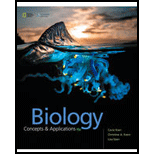
A(n) ______ develops from a two-layer embryo.
| a. sea star | c. butterfly |
| b. sea anemone | d. earthworm |
Introduction:
The environment is composed of a variety of organisms. Animals are the most complex living organisms. They are eukaryotes as they contain a well-defined nucleus enclosed in a nuclear membrane. All kinds of animals reproduce to give rise to their offspring. Animals do not contain a cell wall, and they cannot prepare food. All animals are heterotrophs as they depend on other organisms for their food.
Answer to Problem 1SA
Correct answer:
A sea anemone develops from a two-layer embryo. Hence, the correct answer is option b.
Explanation of Solution
Reason for correct answer:
Option b. is given as “sea anemone.”
The collection of similar type of cells forms tissue. Animals contain tissue and similar kinds of tissue join together to form the organs. Cnidarians are the simpler animals that live in water bodies. The embryo of cnidarians contains two-layer, an outer layer called ectoderm, and the inner layer that is known as endoderm. Sea anemones are the cnidarians that develop from a two-layer embryo.
Reason for incorrect answer:
Option a. is given as, “sea star.”
Seastar is also known as starfish, and it belongs to the phylum “Echinoderm.” Sea star arises from a three-layered embryo. These three layers are outer layer (ectoderm), middle layer (mesoderm), and inner layer (endoderm). This indicates that sea star does not form from a two-layer embryo. Hence, option a. is incorrect.
Option c. is given as, “butterfly.”
Butterfly is not a cnidarian. It is a complex insect that forms from a three-layered embryo. These three layers are outer layer (ectoderm), middle layer (mesoderm) and inner layer (endoderm). This indicates that the butterfly does not arise from a two-layer embryo. Hence, option c. is incorrect.
Option d. is given as, “earthworm.”
Earthworm belongs to the phylum named “Annelid.” It is formed from a three-layered embryo. These three layers are outer layer (ectoderm), middle layer (mesoderm) and inner layer (endoderm). This indicates that earthworm does not arise from a two-layer embryo. Hence, option d. is incorrect.
Hence, the options a., c., and d. are incorrect.
The organism that arises from a two-layer embryo is a sea anemone. Thus, the correct option is b.
Want to see more full solutions like this?
Chapter 23 Solutions
BIOLOGY:CONCEPTS+APPL.(LOOSELEAF)
- Among living animals, only birds have ________. a. a cloaca c. feathers b. a four-chambered heart d. amniote eggsarrow_forwardWhich of the following animals has indirect development (larvae)? A. Salamander B. Bony fish C. Butterfly D. B and C only E. A, B, and Carrow_forwardThe ribs form from the ________. a. notochord b. neural plate c. neural tube d. somitesarrow_forward
- A. Water currents in the ocean are much stronger than any sperm. How do sperm and egg find each other? B. In humans there are no water currents and the volume of the female reproductive tract is relatively limited. Then, why does the male have so many sperm? C. Why do sea urchins have external fertilization? D. Then why don't the parents take care of the young? E. Because the urchin life involves two or more ecological niches, they are more susceptible to predation and exposure to environmental toxins. What environmental conditions, predators and toxins might they be exposed to at each stage?arrow_forwardAlong the notochord, segmented blocks of tissue that give rise to muscles, vertebrae, and connective tissues are calleda. neural crests.b. morulas.c. primitive streaks.d. somitesarrow_forwardan amniotic egg was crucial to the evolution of vertebrates because it provides the following to the embryo a) cushioning b) gas exchange c) protection from drying out d) the amniotic provides all of these e) nutritionarrow_forward
- Characteristics that evolved in birds to allow for flight includea. reptilian-like scales on the legs.b. a hard-shelled amniotic egg.c. internal fertilization.d. thin, hollow bones in the skeleton.arrow_forwardWhich of the following are mismatched? (a) endoderm; lining of the digestive tube (b) ectoderm; circulatory system (c) mesoderm; notochord (d) mesoderm; reproductive system (e) ectoderm; sense organsarrow_forwardAnnelids and_______ have a closed circulatory system. a. insects c. flatworms b. cephalopods d. sea starsarrow_forward
- What is embryology? A. The science of the development of embryos from fertilization to birth B. Microevolution C. A multicellular organism that primarily undergoes extensive and rapid growth D. Macro evolutionarrow_forwardNematocysts are a.) reproductive cells b.)excretory organs c.) set of muscle cells d.) circulatory cells e.) defensive cellsarrow_forwardYou find a flatworm during a field trip and discover that the embryos undergo spiral cleavage. What also must be true of this animal? (can be more than one anwser) E. regulative development B. mosaic development C. it is acoelomate D. All of these A. bilateral symmetryarrow_forward

 Biology (MindTap Course List)BiologyISBN:9781337392938Author:Eldra Solomon, Charles Martin, Diana W. Martin, Linda R. BergPublisher:Cengage Learning
Biology (MindTap Course List)BiologyISBN:9781337392938Author:Eldra Solomon, Charles Martin, Diana W. Martin, Linda R. BergPublisher:Cengage Learning Biology: The Dynamic Science (MindTap Course List)BiologyISBN:9781305389892Author:Peter J. Russell, Paul E. Hertz, Beverly McMillanPublisher:Cengage Learning
Biology: The Dynamic Science (MindTap Course List)BiologyISBN:9781305389892Author:Peter J. Russell, Paul E. Hertz, Beverly McMillanPublisher:Cengage Learning


